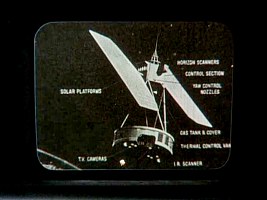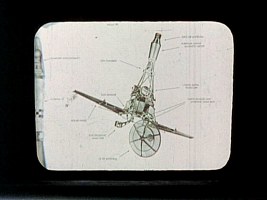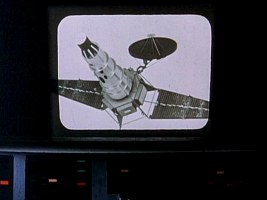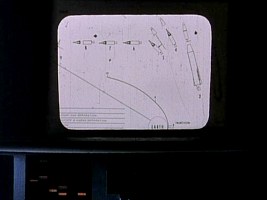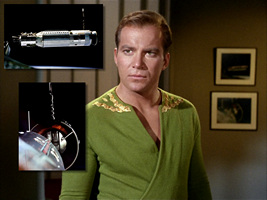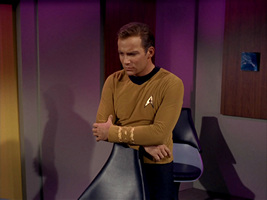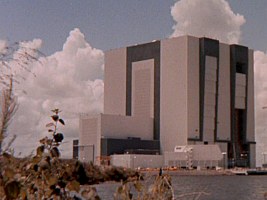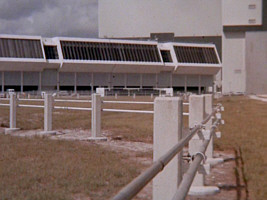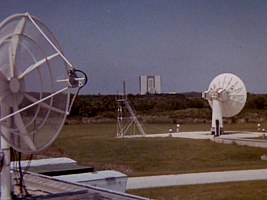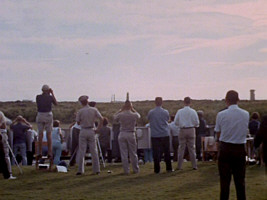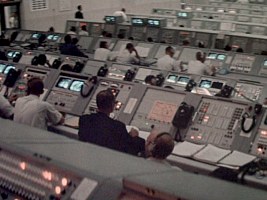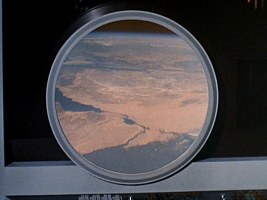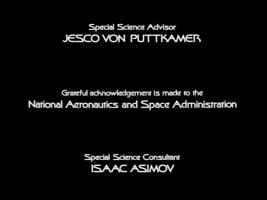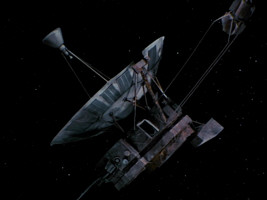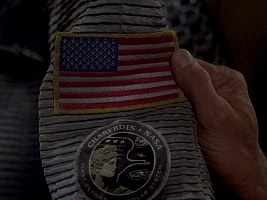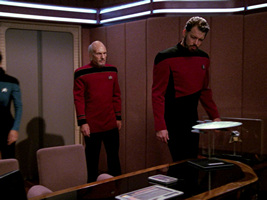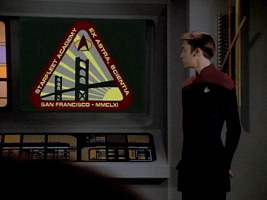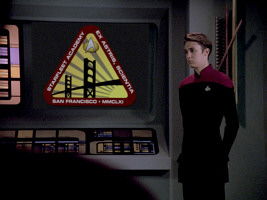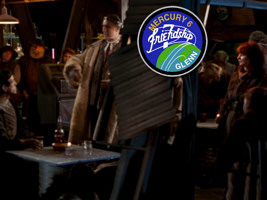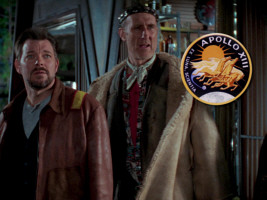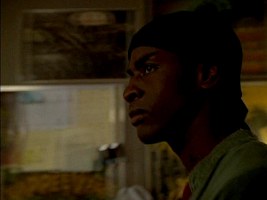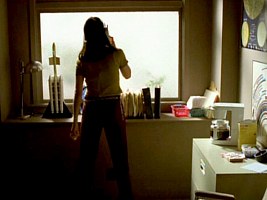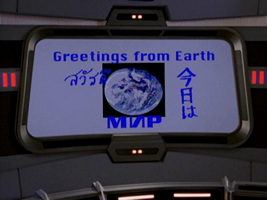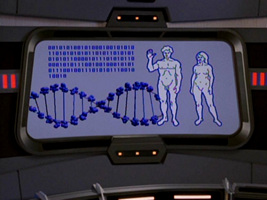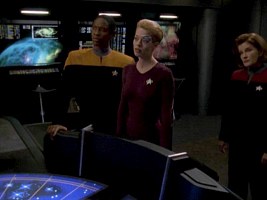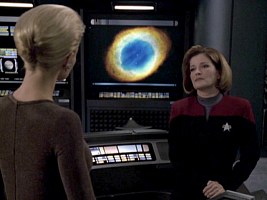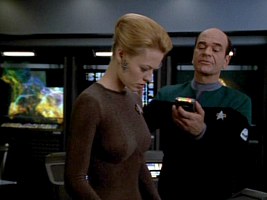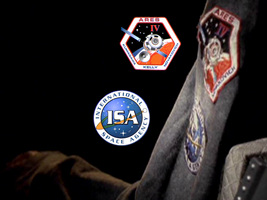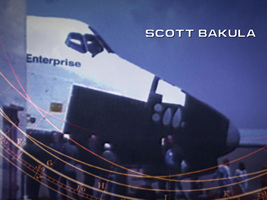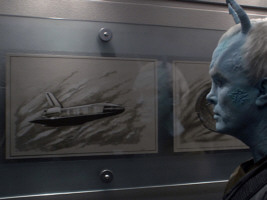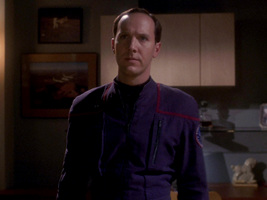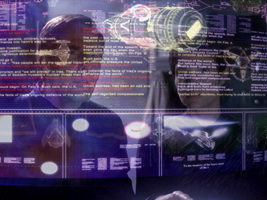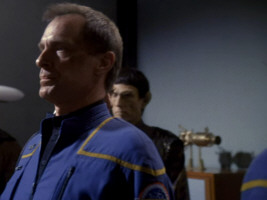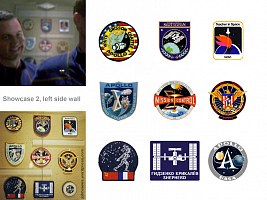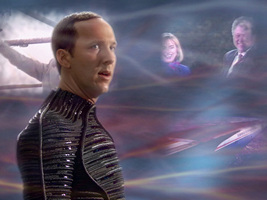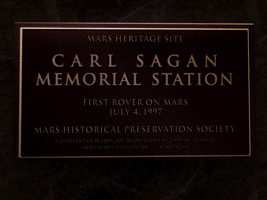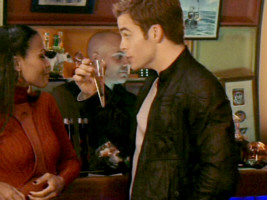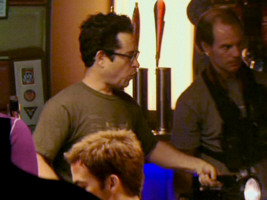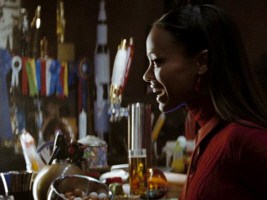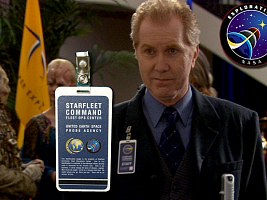NASA References in Star Trek
by Jörg Hillebrand, Mike Okuda and Bernd Schneider
NASA References in TOS and TOS Movies TNG and TNG Movies DS9 VOYENTStar Trek (2009)Addendum
 We will take care of the NASA references in the most recent Trek TV series since 2017 at a later date.
We will take care of the NASA references in the most recent Trek TV series since 2017 at a later date.Naturally, as an American TV series, Star Trek focuses on the National Aeronautics and Space Administration (NASA) whenever references are deemed necessary or beneficial. The following list comprises all kinds of visual and verbal references to real NASA space programs. It is a very long page already, but still not complete.
NASA References in TOS and the TOS Movies
The Cage
We can see a large number of NASA spacecraft as soon as in the first Star Trek pilot episode, "The Cage". When the Talosians examine the Enterprise's library computer, they find anatomic diagrams of humans, maps, pictures of plants and animals, as well as the following rockets, probes and satellites.
- Explorer S-55 micrometeoroide satellite: This could be any out the series S-55a (Explorer 13), b (Explorer 16) or c (Explorer 23). More information can be found at Gunter's Space Page.
- Mariner 2: The probe was launched to Venus in 1962. We can see the same picture of this probe twice. The second time it is just rotated.
- Nimbus I: Two different images of the weather observation satellite of 1966 are visible. The first one has call-outs for the single components, the second one illustrates its operation range.
- Orbiting Geophysical Observatory (OGO) and Orbiting Solar Observatory (OSO): They can be seen on the same screen, and are accordingly labeled.
- Pioneer 5: The interplanetary probe, launched in 1960, is visible on one screen.
- Ranger Block 1 type: It is not definitely recognizable which Ranger mission is depicted, but it must be a spacecraft of the Block 1 from 1961.
- Ranger Block 2-3 type: Once again it is not possible to identify a specific probe. It has features of both the Ranger Block 2 and Block 3, timeframe 1962-65.
- Ranger 3: The depicted probe belongs to Block 2. It is Ranger 3, to be more specific. It was launched in 1962 and turned out a failure when it missed the moon.
- A possibly generic flight path of a Ranger probe is depicted too.
- Finally, we can make out a very schematic depiction of the launch of a two-stage rocket carrying a probe. Most likely the spacecraft is of the Atlas-Agena type.
 The scene has been completely reworked for TOS-R, reflecting more recent developments in space travel than those of the 1960's.
The scene has been completely reworked for TOS-R, reflecting more recent developments in space travel than those of the 1960's.
TOS: Court Martial
In the hallway to Commodore Stone's office on Starbase 11 we can notice the picture of a Titan II rocket. Memory Alpha provides the following information: "The photo, appearing in 'Court Martial', depicts the Project Gemini capsule on a Titan II rocket. It is one of many photos taken in 1965 and 1966 for public use by NASA." There are more space-related pictures in Stone's office. The upper picture behind Kirk is a side view of the Agena test rocket on the Gemini 8 mission. The lower one is an Agena too, this time head-on shortly before docking.
TOS: The Menagerie I
We can see something that looks like a satellite image in Commodore Mendez's office in TOS: "The Menagerie I". This is likely a NASA photo but not yet identified.
TOS-R: Space Seed
 Many years after the conclusion of TOS there were considerations to make the Botany Bay mission that would take place as soon as in the 1990s more plausible. In VOY: "Future's End", the Botany Bay model appears with booster rockets. When a CGI model of the ship was built for TOS-R: "Space Seed", it was supplemented with a docking port. Mike Okuda: "...the top of the 'conning tower' now has a tiny circular docking port, very similar to those used on the real-life International Space Station. The docking port was added at the suggestion of a former NASA engineer who noted that a spacecraft built in 1996 would probably have included such equipment to dock at the station."
Many years after the conclusion of TOS there were considerations to make the Botany Bay mission that would take place as soon as in the 1990s more plausible. In VOY: "Future's End", the Botany Bay model appears with booster rockets. When a CGI model of the ship was built for TOS-R: "Space Seed", it was supplemented with a docking port. Mike Okuda: "...the top of the 'conning tower' now has a tiny circular docking port, very similar to those used on the real-life International Space Station. The docking port was added at the suggestion of a former NASA engineer who noted that a spacecraft built in 1996 would probably have included such equipment to dock at the station."
TOS: Return to Tomorrow
When he decides to take the risk of the mind transfer, Kirk says: "Do you wish that the first Apollo mission hadn't reached the moon, or that we hadn't gone on to Mars and then to the nearest star?"
TOS: Assignment: Earth
We can see a lot of footage from the launch of Apollo 4, the first flight of a Saturn V rocket, then still unmanned. In the episode the scene is described as showing the launch of a nuclear warhead platform from McKinley Base, however. The episode also shows numerous shots of exteriors and interiors of NASA buildings in the Kennedy Space Center. Among them are exterior views of the huge Vehicle Assembly Building, as well as interior shots of one of the four firing rooms, located in a building next to the Vehicle Assembly Building.
Furthermore there are pictures of Earth taken from space, probably from the Apollo 4 mission as well. One of them is a view of the Sinai Peninsula. The shot has been flipped: The Suez Canal and the Great Bitter Lake are in the lower center of the screen, with the Red Sea in the left center, and the Mediterranean Sea at the bottom. The Sinai Peninsula occupies the complete center of the screen, while the rest of Egypt is on the lower left side.
TOS: The Cloud-Minders
The view from space of a parched riverbed on Ardana is actually a NASA photo. The shots in the original and in the remastered episode are based on the same basic photo of Wadi Hadramawt. Mike Okuda: "The image of the planetscape is based on the same photograph used by Cinema Research Corp in creating the episode's original visual effects in 1969. That photograph was taken by astronauts on the Gemini IV orbital mission in 1965 and shows the Hadramawt Plateau dry river basin in Yemen."
 The same photo is used in the TOS-R episode. Mike Okuda: "For the remastered effect, Dwayne A. Day of the National Research Council and John Hargenreder of the NASA History Office combed through NASA archives at NASA Headquarters in Washington D.C. to find the original photograph for the remastered visual effects team. (The distant mountains on the horizon are based on a different photo, taken by astronauts on the International Space Station.)"
The same photo is used in the TOS-R episode. Mike Okuda: "For the remastered effect, Dwayne A. Day of the National Research Council and John Hargenreder of the NASA History Office combed through NASA archives at NASA Headquarters in Washington D.C. to find the original photograph for the remastered visual effects team. (The distant mountains on the horizon are based on a different photo, taken by astronauts on the International Space Station.)"
The aforementioned distant mountains are visible on another new take made for the remastered episode, with a close view of Ardana in the foreground. The lower half of this image's background shows the Gemini IV photo again that has been distorted to accommodate the different perspective.
Star Trek: The Motion Picture
The image of the Enterprise flying past Jupiter was done with a model of the planet that was closely based on photos taken by NASA's Voyager spacecraft. We can spot the Space Shuttle Enterprise OV-101 on the recreation deck, among other vessels of this name. The Voyager VI probe that turns out to be the core of the enormous entity V'ger is a fictional later model of NASA's probes Voyager 1 and Voyager 2, both launched in 1977. Decker explains the meaning of the acronym on the probe's dedication plaque as "NASA: National Aeronautics and Space Administration". Finally, the end credits include Jesco von Putkamer as the movie's scientific advisor and a general acknowledgment of NASA.
Star Trek: The Wrath of Khan
NASA and JPL are gratefully acknowledged in the movie's end credits.
Star Trek: The Search for Spock
The USS Grissom is named for NASA astronaut Virgil I. "Gus" Grissom, who lost his life in the Apollo 1 disaster in 1967. Likewise, the Excelsior-class ship Grissom NCC-42857 (TNG: "The Most Toys", DS9: "Field of Fire") honors the astronaut. Both Starfleet ships are lost with (almost) all hands...
Star Trek: The Voyage Home
Between the flashback of the preceding two movies of the trilogy and the opening credits, this film is dedicated to the victims of the Challenger disaster with the words: "The cast and crew of Star Trek wish to dedicate this film to the men and women of the spaceship Challenger whose courageous spirit shall live to the 23rd century and beyond..."
The USS Shepard is mentioned in the same movie, named for Alan B. Shepard (1923-1998), NASA astronaut and first American in space.
Star Trek: The Final Frontier
The Klingons destroy a human-made probe as target practice. It is Pioneer 10, adorned by the famous plaque that was added as a greeting to potential aliens that might find the probe without immediately firing on it. The plaque shows who launched it (the illustrations of people), where they lived (the diagram of our solar system) and when it was launched (the radial lines indicating the locations and frequencies of pulsars, which serve as a cosmic calendar).
NASA References in TNG and the TNG Movies
TNG: The Royale
The Charybdis of 2037 is a NASA spaceship. A salvaged hull fragment of the ship bears a US flag with 52 stars (with a wrong size of the blue field relative to the red and white stripes), as well as the NASA "worm logo". This version of the NASA logo was in use only until 1992 but was reinstated in 2020. On Col. Stephen G. Richey's spacesuit we see a smaller version of the 52-star flag and a mission patch. This patch is identical to that of the Apollo 17 mission. The names of the three Apollo astronauts Cernan, Evans and Schmitt and the Roman numerals "XVII" are still readable, only the letters "APOLLO" were removed.
 The patch was digitally modified for TNG-R. It is essentially still the mission logo on Apollo XVII. But the number "XVII" was replaced with "Charybdis - NASA", and the names of the Apollo 17 astronauts with "First Beyond the Solar System".
The patch was digitally modified for TNG-R. It is essentially still the mission logo on Apollo XVII. But the number "XVII" was replaced with "Charybdis - NASA", and the names of the Apollo 17 astronauts with "First Beyond the Solar System".
TNG: Time Squared
A shuttlepod is named for planetary geologist Farouk El-Baz, who worked for NASA from 1967 to 1972. El-Baz was responsible for selecting the landing sites of the Apollo missions. The same shuttle reappears in TNG: "Transfigurations" and "Descent".
TNG: The Ensigns of Command
A shuttlepod is named in honor of astronaut Ellison Onizuka, who lost his life in the Challenger disaster of 1986. The so named shuttle also appears in TNG: "The Mind's Eye" and "The Outcast".
TNG: Future Imperfect
In Barash's holographic simulation Will Riker has been promoted to the captain of the Enterprise. In his ready room a miniature of the Apollo Lunar Module replaces Picard's model of a Constellation-class ship. It is the first time that the model of an authentic spacecraft appears on Star Trek.
TNG: The First Duty
The motto of Starfleet Academy, "Ex Astris, Scientia", is based on that of Apollo 13, "Ex Luna, Scientia". In the original version of "The First Duty", a grammatically wrong logo reading "Ex Astra, Scientia" is displayed. We don't expect the Latin language to change until the 24th century, so the preposition "ex" must be followed by an ablative case. It has to be "astris", never the accusative plural "astra". Mike Okuda quickly produced a correct version when he was notified of the error by a professor.
Furthermore Wesley has a model of the Apollo Command and Service Module in his quarters at the Academy, besides a model of the original Enterprise NCC-1701.
 The incorrect motto on the Academy logo was fixed for the remastered episode.
The incorrect motto on the Academy logo was fixed for the remastered episode.
TNG: Chain of Command I
Captain Edward Jellico brings his own model when he takes over the command of the Enterprise in the first part of this double feature. It is a Rockwell X-30, a completely reusable single-stage-to-orbit vehicle that was being considered at the time the episode was being filmed (1992). Yet, the X-30 project was scrapped in 1993. A CGI of the same ship will be shown in ENT: "Storm Front, Part II".
TNG: Second Chances
Mae Jemison, Mission Specialist on STS-47 in 1992, appears in the credited role of Lt. JG Palmer. She operates the transporter.
Star Trek: First Contact
The rocket that carries the warp ship Phoenix into space is an old Titan II. The Titan II was first launched in 1962. Initially intended to carry nuclear warheads, the ICBM was soon developed to carry payloads in the space programs of the USAF as well as of NASA. Most notably it served as a launch vehicle for the Gemini series. The particular Titan II in the movie is an ICBM of the USAF, however.
There are several NASA mission logos in Cochrane's camp in Bozeman. We can recognize the following patches:
- Mercury 6 / Friendship 7 (1962)
- Apollo 13 (1970)
- Apollo 15 (1971)
- Skylab (generic)
- Space Shuttle STS-41G (1984)
- Space Shuttle STS-51L (1986, the Challenger tragedy)
- Space Shuttle STS-33 (1989)
There are a few more, including the patch for STS-52, which carried a small, sealed container with a small amount of Gene Roddenberry's ashes into orbit. The emblem was later presented to Majel Roddenberry.
Lake Armstrong on the Moon is obviously named for Neil Armstrong. Finally, it is worth mentioning that Zefram Cochrane refers to the Enterprise crew as "astronauts", which is otherwise a very uncommon term in Star Trek.
Star Trek: Insurrection
A monitor on the Enterprise-E depicts a Saturn rocket, as well as the famous eagle patch of Apollo 11.
NASA References in DS9
DS9: The Homecoming
Since "The Homecoming" Sisko's office is decorated with a model of the International Space Station ISS. Only in this first episode the miniature is located in a glass showcase next to the door. In the following two episodes of the trilogy, "The Circle" and "The Siege", it cannot be found here. In "Cardassians" we see the ISS again, but now without a glass casing, next to the sofa. The Star Trek Encyclopedia tells us: "Ben Sisko's ISS model was provided by Majel Barrett Roddenberry, who presented it as a gift to the show. The Star Trek: Deep Space Nine art department made one tiny modification to the model. They changed the name on a model space shuttle, docked to the station, to bear the name Enterprise, even though the real shuttle Enterprise never flew in space."
DS9: Past Tense I/II
According to the DS9 Companion, "One of Takemura's [special effects supervisor] tasks was to render a shot of the Defiant orbiting Earth. 'I used an eight-by-ten NASA transparency of the real Earth to create the footage,' he says. Takemura designed a motion control move that had the transparency panning in one direction while the motion control camera itself panned in the other direction. The shot resulted in an image of the Earth that did not look static. 'I thought it was a nice shot,' he says modestly."
DS9: Paradise Lost
The Academy emblem from TNG: "The First Duty" appears in correct Latin, unlike in the original version of TNG: "The First Duty". The name of Cadet Riley (Aldrin) Shepard is a blend of Buzz Aldrin and Alan Shepard. He will reappear in DS9: "Valiant".
DS9: Apocalypse Rising
The USS Armstrong is mentioned to have been ambushed by Klingons. Most likely the ship has been named for Neil Armstrong, American astronaut and first man to set his foot on the Moon.
DS9: The Sound of Her Voice
The shuttlecraft Chaffee commemorates the astronaut Roger B. Chaffee, who died in the Apollo 1 fire in 1967.
DS9: Afterimage
The USS Destiny may have been named for the ISS science module of this name.
NASA References in VOY
VOY: Non Sequitur
The wrong Latin on the Academy emblem from TNG: "The First Duty" was fixed prior to this episode. We can also make out a document on Harry's office wall with the Apollo 11 eagle patch that is related to the 400th anniversary of the first manned moon landing.
VOY: Threshold
Janeway suggests that with his transwarp flight Tom Paris will join the ranks of Orville Wright, Neil Armstrong and Zefram Cochrane.
VOY: Future's End I/II
Among various space, sci-fi and horror paraphernalia in Rain Robinson's office in the Griffith Observatory, there is a picture showing Alan Shepard on the Moon during the Apollo 14 mission. Above the photo there is a fake newspaper clipping that Mike designed for the set. The clipping's headline reads "LIFE ON MARS?" and includes the famous electron microscopy image of ALH84001, showing the suspected ancient Martian life. Mike Okuda composed this from a NASA press release. "I also used the image of the ALH-84001 in a poster that I did for the wall. The possible life-form has a word balloon, saying 'Take me to your leader!'"
We can see a model of the Botany Bay, now equipped with Space Shuttle style booster rockets, as well as a photo of this configuration. Furthermore Rain has a replica of the SETI plaque on the Pioneer probes (Carl Sagan's "interstellar greeting card"), as it already showed up in "Star Trek V".
When her SETI program reveals Voyager's presence in Earth's orbit, Rain sends a greeting consisting of "Welcome" or "Peace" in different human languages, the human figures and pulsar schematic from the Pioneer plaque, a sample of binary code and of DNA.
A placard behind her monitor shows the Drake Equation, as well as Roddenberry's bogus version of the Drake Equation that he used in his original Star Trek series outline.
VOY: Year of Hell
Nearly all space photos used to decorate the new Astrometric Lab since this episode were taken by the Hubble Telescope. We can see in alphabetical order: 47 Tucanae, Bubble Nebula, Cat's Eye Nebula, Eagle Nebula, Eta Carinae Nebula, M2-9 Nebula, Ring Nebula, Trifid Nebula, Veil Nebula. An older photo of the Ring Nebula was already frequently visible on bridge monitors in TOS. One exception is the photo of Saturn's rings from the probe Voyager 2.
VOY: Timeless
The USS Challenger in this episode is named for the Space Shuttle of the same name. The registry NCC-71099 of the Galaxy-class vessel is a clear homage to the number OV-099 of the ill-fated shuttle. With the prototype vessel of the 24th century Challenger class (Star Trek Encyclopedia) and the old USS Challenger NCC-2032 ("Star Trek VI"), there are at least two previous Starfleet ships of the same name.
VOY: 11:59
The episode deals with Shannon O'Donnell, an aerospace engineer who hoped to become an astronaut with NASA but failed the training.
A miniature of the Apollo Lunar Module is dangling from the interior mirror in Shannon O'Donnell's car. It is a Hallmark ornament normally placed on Denise Okuda's desk. In a dream sequence, Shannon recalls watching the first Moon landing as a kid, and the famous line "One small step..." by Neil Armstrong is replayed. Yet, we checked the footage and found that the visuals are actually of Buzz Aldrin.
VOY: One Small Step
The episode title is taken from Neil Armstrong's famous words: "One small step for a man... but a giant leap for mankind." Chakotay remarks that "Kelly and Kumagawa [of Ares IV], Armstrong and Glenn, they were the real pioneers."
The hull of the Ares spacecraft to Mars and John Kelly's uniform bear the round logos of the ISA (International Space Agency) and the hexagonal one of the Ares mission. The name and patch design of the ISA are a tip of the hat to NASA. Inside the capsule, beside the Ares logo, there appears to be another patch, apparently the one depicted in the Star Trek Fact Files and there falsely labeled "Aries" (Aries = Ram, Ares = Mars). The interior of the capsule included some Space Shuttle mission emblems, but they are not visible in the episode.
Interestingly, the recordings of the Ares IV mission are tagged with "NASA/ISA", hence indicating that NASA still exists at the time of the mission (2032). This is in agreement with the Charybdis, which is a NASA ship in 2037, as seen in TNG: "The Royale". Moreover, Chakotay mentions NASA's involvement in the Ares mission twice.
VOY: Nightingale
When Harry moves into the ready room of the Nightingale, he decorates the wall with the document celebrating Apollo 11's 400th anniversary, the one already seen in "Non Sequitur". We can read "1969" to the left and "2369" to the right of the mission patch.
NASA References in ENT
Opening credits
The opening credits of Enterprise were described almost shot by shot in a now defunct article at startrek.com. Focusing on the NASA references, we can see:
- Mercury-Redstone schematics (one of two occurrences), here as an overlay to the Spirit of St. Louis
- Enterprise OV-101 roll-out
- Chuck Yeager and Bell X-1
- Apollo astronauts on their way to the launch
- Alan Shepard
- Saturn V launch (later blended with a shot of Robert Goddard at the blackboard)
- Space Shuttle launch (also of the astronauts inside, not depicted)
- Saturn V interstage separation
- Astronaut in EVA suit
- Aldrin's footprint on the Moon
- Apollo Lunar Module
- Sojourner on Mars
- Space Shuttle Atlantis with Spacehab module
- International Space Station (different development stages)
- Future shuttle OV-165 (design and number inspired by NASA standards)
- Titan rocket with Phoenix
One thing to notice about the Space Shuttle roll-out is that the Enterprise OV-101 originally didn't have the black frames around the windshield and the black/white paint/tile scheme around the RCS. The orbiter was later modified to resemble the other Space Shuttles, but the name "Enterprise" was never written as close to the cockpit window as on the footage in the opening credits. The footage shows a different Space Shuttle, and the lettering was replaced to read "Enterprise".
In the Mirror Universe version of the credits, created for "In a Mirror, Darkly", all NASA references but the Saturn V lift-off were dropped. A newly created take shows how an astronaut plants the imperial flag of Mirror Earth on the Moon.
ENT: Broken Bow
The charcoal drawing of the Space Shuttle Enterprise adorns the wall of Archer's ready room throughout the series.
ENT: Silent Enemy
Mark Latrelle's shoulder patch is that of NASA Mission Control in Houston. A special design for this barely visible emblem was not deemed necessary.
In the same episode, Trip Tucker says about the risks of space travel: "In the old days, astronauts rode rockets with millions of liters of hydrogen burning under their seats. You think they said, 'gee, I'd love to go to the moon today but it seems a little risky'?"
ENT: Shockwave I
In a corner of his apartment Archer has a photo of Pete Conrad, standing on the Moon and holding the flag.
ENT: Carbon Creek
Sputnik is not exactly a NASA spacecraft. Nevertheless we found its inclusion quite fitting.
There is also an interesting small dialogue in the episode, in relation to the early Vulcan visit to Earth:
Tucker: "Do you realize you've just rewritten our history books?"
T'Pol: "A footnote, at best."
Tucker: "Footnote? This is like finding out Neil Armstrong wasn't the first man to walk on the moon."
T'Pol: "Perhaps he wasn't."
ENT: Future Tense
There is a "history" sequence that probably includes the opened cargo bay of a Space Shuttle (looking at the aft end with the vertical stabilizer).
ENT: Regeneration
In this episode, and once again in "The Expanse", we can glimpse a model of the Space Shuttle on the launch pad (complete with booster rockets) in Admiral Forrest's office.
ENT: First Flight
The model of the Apollo Command and Service Module in Forrest's office may be still the same as Wesley's in TNG: "The First Duty". In addition, there is a golden miniature of the Apollo spacecraft including the Lunar Module, which will reappear in "The Expanse" and "Home" in different corners of the office. On a wall in the 602 Club there is a photo of the Botany Bay model with booster rockets from VOY: "Future's End".
Most notably several NASA mission patches can be seen in the 602 Club, in three showcases altogether. In addition, there is at least one emblem of the ESA and three of the Russian Space Agency. Mike Okuda bought all these patches in a shop in Houston. A fourth showcase houses fictional emblems from the Star Trek Universe.
Also in "First Flight", Archer is talking to waitress Ruby:
Archer: "Do you remember what Buzz Aldrin said when he stepped on the moon?"
Ruby: "No."
Archer: "Nobody does, because Armstrong went first."
Actually, Aldrin's first words were "Magnificent desolation".
ENT: The Expanse
The Columbia NX-02 is under construction. Due to its registry and its position as the second vessel of the class after a prototype named Enterprise it is clear that the starship is named for the NASA Space Shuttle Columbia OV-102 that was lost with seven crew members during its re-entry in 2003.
Besides the already mentioned Apollo models and the shuttle on the launch pad in Forrest's office we can make out a small miniature, possibly the Bell X-1.
ENT: Storm Front II
The following NASA spacecraft are visible in the timestream that Daniels presents to Archer:
- Apollo Lunar Module
- Saturn V launch
- Space Shuttle launch
- Satellite in cargo bay
- ISS
- Rockwell X-30 as a computer rendition
ENT: Home
The golden Apollo model reappears in Forrest's office, as well as a golden Space Shuttle. The tubular model below the Space Shuttle is a study model that happened to be lying around, not a real spacecraft. There is also the picture of the DY-100 launch already known from the 602 club in "First Flight".
ENT: Affliction
Section 31 operative Harris seems to have a Space Shuttle model as well. There is also a miniature of the Sojourner Mars rover on some shelf, as Mike remembers, but it is not visible on screen.
ENT: Terra Prime
We can see the memorial for Sojourner on Mars, which was officially christened "Carl Sagan Memorial Station" by NASA.
ENT: These Are The Voyages
NASA astronauts Terry Virts and E. Michael Fincke can be seen in the Enterprise series finale.
NASA References in "Star Trek (2009)"
 The shipyard bar in "Star Trek (2009)" is full of memorabilia of spaceflight history. In the take with Gerald W. Abrams (right), J.J. Abrams's father, and James McGrath, Jr., his father-in-law, we can see the photo of an astronaut on the wall behind the bar. When Kirk is beaten up by the cadets, we can recognize the famous photo of Buzz Aldrin in the background. There are also patches from various NASA missions behind the bar. At least two of the ones on the right are USAAF patches from the Second World War though. The round one is 8th USAAF, the triangular one is 12th USAAF.
The shipyard bar in "Star Trek (2009)" is full of memorabilia of spaceflight history. In the take with Gerald W. Abrams (right), J.J. Abrams's father, and James McGrath, Jr., his father-in-law, we can see the photo of an astronaut on the wall behind the bar. When Kirk is beaten up by the cadets, we can recognize the famous photo of Buzz Aldrin in the background. There are also patches from various NASA missions behind the bar. At least two of the ones on the right are USAAF patches from the Second World War though. The round one is 8th USAAF, the triangular one is 12th USAAF.
There is a Saturn V model, and the ceiling of the bar is adorned by several more models of spacecraft. Finally, we can see two photos of experimental aircraft, namely of the X-1E with test pilot Joseph Walker and of the X-15. Well, these are technically not NASA vehicles but close enough.
Addendum
Here are some more NASA references that were not openly visible or spoken out on camera.
Starships
The names of the following Federation spacecraft are possible NASA references:
- Apollo class (Star Trek Encyclopedia)
- USS Eagle NCC-956 (flip chart in "Star Trek VI")
- Freedom class (Star Trek Encyclopedia). In 1990, when TNG: "The Best of Both Worlds" was filmed, the name may have been supposed to honor the space station that would become the ISS.
- USS Hauck (Star Trek: The Magazine). Named for Frederick Hauck, American astronaut. The ship name is from a Star Trek Magazine article by Rick Sternbach.
- USS Helin NCC-1692 ("Star Trek VI"). Eleanor Francis Helin is an American astronomer, who retired in 2002.
- USS Scovil NCC-1598 ("Star Trek VI"). Named for Jack Scovil, American astronaut.
Star Trek Voyager
For later seasons the Voyager "speedboat" shuttle Cochrane was relabeled "Harris", for Jennifer Harris, a flight director at NASA's Jet Propulsion Laboratory who worked on the Mars Pathfinder mission.
ENT: Demons & Terra Prime
For the intergalactic conference Mike Okuda built ID badges, on whose back he included, beside the United Earth emblem, a logo that he designed for the NASA's exploration programs. Only the letters "NASA" are missing on the Trek version.
See Also
The Library Computer Scene of "The Cage" in TOS and TOS-R - shot-by-shot comparison
Observations in TNG: "The Royale"
Astronaut & Cosmonaut Memorial - for the men and women who lost their lives exploring space
Credits
Some screen caps from TrekCore and TrekCaps. The missing mission patches from ENT: "First Flight" could be identified thanks to high-resolution images posted at Eavesdropping with Johnny. Thanks to James Y. Yeh for identifying the USAAF patches in "Star Trek (2009)", to Matt and J who recognized the Agena rocket in "Court Martial" and to Timo Saloniemi for finding out that the Enterprise opening credits don't show the roll-out of the Enterprise OV-101.

NASA @ Memory Alpha






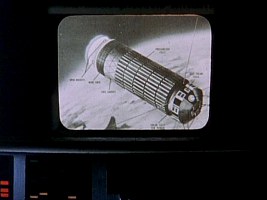
 Explorer S-55 micrometeoride satellite in "The Cage"
Explorer S-55 micrometeoride satellite in "The Cage"
